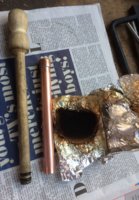Should I still do a leak down test with these results?
I wouldn't bother. A Leakdown Test is great for identifying where your problem is, if you have one. (For example, you see a significant leakdown number, say 20%; then, with the air still on, listen at the oil fill, carbs, and exhaust to determine if the leak is from bad rings, intake valves, or exhaust valves).
The other thing it's good for is if you want to track engine wear over a prolonged period. (For example, track wear after every race weekend, build a database and then use that data to determine when you need to tear the motor down).
In your case, it doesn't sound like you've got a problem (based on good compression numbers), it's not a race bike, and (in my experience) the HF gauge isn't repeatable enough to use for long-term testing in any event.
You've got excellent compression readings. I'd start chasing that "no-start" problem next. If you're bored this winter, maybe play with the leakdown tester!
Good luck!
Michael




